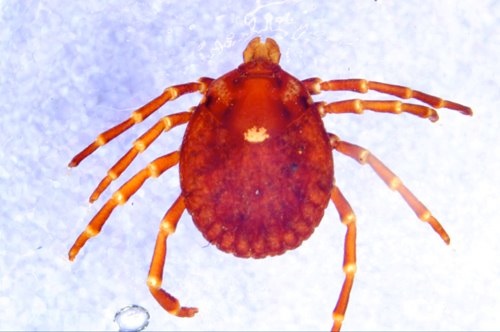Kangaroo Ticks

MONDAY, OCTOBER 16, 2006
Ticked Off
I've been picking kangaroo ticks off of my body for the last 24 hours. Before leaving Gingin for home yesterday afternoon, we checked ourselves and removed numerous kangaroo ticks. I found only four or so, while Christobel was up into the teens.
The ticks were duly removed and destroyed - crushing them is difficult, and, I am told, if you drop them to the ground, they just crawl back up onto you. So drowning was deemed the best option, or live burial.
At home, after showering, a few more were discovered. That should have been the end of it, as we had left the bush behind us. But I found another this morning, and several more this afternoon, all in quite conspicuous spots that they hadn't been in earlier.
The Kangaroo Tick, Amblyomma triguttatum, from Western Australia
Where were these ticks coming from? The originals had been picked up out in the bush. We'd seen numerous kangaroo tracks, seen a pair of kangaroos trying to jump through a new fence, and heard them around the camp at night. Where there are kangaroos, there are kangaroo ticks. But where might they be coming from in Freo?
We had two theories. One was that they might have gotten into our clothes and other belongings, and crawled out later to find victims. This theory is supported by the fact that a live tick was discovered in the laundry after washing (in Max's knickers, poor thing). And it suggests that death by drowning might not be the best option after all.
The other theory is that the ticks have gotten into our vehicles and keep infesting us every time we drive somewhere. I think this may be true, because it fits the time frame of the discoveries. If it is indeed true, I pity the person that gets my rental car next.
More info on kangaroo ticks follows, because I went to all the trouble to find it, and the only useful items were on page 4 or 5 of my Google search.
From the 1998 National Environmental Health Forum:
In Australia there are approximately 70 species of tick and they are often encountered in theAustralian bush. Ticks can be divided into two families, the soft ticks (family, Argasidae) and the hard ticks (family, Ixodidae). The soft ticks have a wrinkled appearance and only a few species arefound in Australia. Most of the ticks found in Australia are hard ticks. These have a hard dorsal plate and elongated mouth parts that have rows of backward pointing teeth.
.....Another prevalent tick species, is the kangaroo tick (Amblyomma triguttatum), which is found in many areas across drier inland parts of Australia where there is uncleared scrub and high populations of bush kangaroos. Kangaroo ticks will grip onto the skin of kangaroos and can also infest dogs, sheep and other animals, including humans. The bite of the kangaroo tick will cause less severe symptoms than the paralysis tick, although it can cause localized skin lesions.
Prevention & control measures
The best method of controlling and avoiding ticks, is to stay away from tick infested areas. Ticks remain outdoors and do not normally infest houses. People in fringe metropolitan suburbs and the country are most likely to be affected by ticks. To minimize the transmission of ticks, native animals (such as bush kangaroos and bandicoots) should be discouraged and the undergrowth should be reduced in these areas.
If visiting outdoor areas (i.e., bushwalking, camping or picnicking), light coloured clothing should be worn to detect ticks more easily. An insect repellent containing diethyl meta-toluamide (DEET) or dibutylphthalate (DBP) should also be applied or smeared onto clothing and skin before bush walking. In the event of severe tick infestations it may be necessary to apply a pesticide treatment in some areas adjacent to the bush. Registered pesticides which can be used against ticks include fenthion, malathion and pyrethrins.
Children and pets should be examined for ticks after visiting a tick-infested area (e.g. bushland). All clothing should be removed and the body searched for ticks especially behind the ears and on the back of the head.
The tick should be removed as close to the skin’s surface as possible with the aid of a fine pair of forceps using a firm grip. Caution should be taken not to grasp and pull the body of the tick as this can cause the tick to inject more toxin into the host. To minimize this from occurring, a small amount of petroleum jelly or repellent containing DEET can be applied onto the body of the tick to kill it prior to its removal from the skin. Any mouth parts which still remain embedded will eventually slough off. If there are any residual symptoms from the tick bite, it is recommended that a medical practitioner be consulted.
Luckily, my only symptom from the tick bites (so far) has been disgust. No itching, no redness, no lumps or bumps. I'm keeping my fingers crossed. Although I do get a bit itchy just thinking about a bloodsucking bug attached to my skin with its long, sharp teeth......
Main 2006 Page
From my blog, “Luba Down Under”






